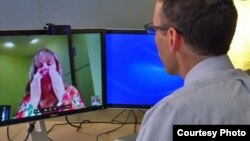TACOMA, WASHINGTON —
Picture youself at home with a bad cold, aching face and green mucus leaking from your nose. You can barely get out of bed, let alone get to a clinic. That was the predicament Diana Rae found herself in recently. The nurse educator from the small town of Tenino, Washington, called her doctor and described her symptoms, and eventually got a prescription.
But she could have talked to and been seen by a doctor from the comfort of home. All she needed was a wifi-connected device and a video-chat software, such as Skype.
Ben Green, a doctor with Franciscan Virtual Urgent Care in Tacoma, Washington, has patients describe their symptoms using this video conferencing method. The video chat allows the doctor to perform a physical exam by mimicking what he wants his patient to do.
Green says a patient's ailment can be treated remotely about 75 percent of the time.
"Patient safety is really important to us," he said. "So if we feel like the patient is not safe to be treated in this manner, we're going to suggest other alternatives for them."
Franciscan Health System charges $35 for the virtual house call, which is much cheaper than going to an emergency room, doctor’s office or urgent care clinic.
It's a service Diana Rae says she'd pay for.
"I would've paid twice that for the convenience of getting taken care of without having to sit in a waiting room, wait, and get exposed to everyone else's germs," she said.
Franciscan, which runs hospitals, clinics and a hospice, contracted with tele-health company Carena to add virtual urgent care delivered via Skype or phone. Carena is one of several companies doing this around the country. But an executive there laments that state regulations haven't kept pace with telemedicine.
The virtual urgent care staff must be separately licensed in each state where it does business. Which means, for now, Carena doctors can diagnose and treat in Washington and California for example, but not in neighboring Oregon and Idaho.
But she could have talked to and been seen by a doctor from the comfort of home. All she needed was a wifi-connected device and a video-chat software, such as Skype.
Ben Green, a doctor with Franciscan Virtual Urgent Care in Tacoma, Washington, has patients describe their symptoms using this video conferencing method. The video chat allows the doctor to perform a physical exam by mimicking what he wants his patient to do.
Green says a patient's ailment can be treated remotely about 75 percent of the time.
"Patient safety is really important to us," he said. "So if we feel like the patient is not safe to be treated in this manner, we're going to suggest other alternatives for them."
Franciscan Health System charges $35 for the virtual house call, which is much cheaper than going to an emergency room, doctor’s office or urgent care clinic.
It's a service Diana Rae says she'd pay for.
"I would've paid twice that for the convenience of getting taken care of without having to sit in a waiting room, wait, and get exposed to everyone else's germs," she said.
Franciscan, which runs hospitals, clinics and a hospice, contracted with tele-health company Carena to add virtual urgent care delivered via Skype or phone. Carena is one of several companies doing this around the country. But an executive there laments that state regulations haven't kept pace with telemedicine.
The virtual urgent care staff must be separately licensed in each state where it does business. Which means, for now, Carena doctors can diagnose and treat in Washington and California for example, but not in neighboring Oregon and Idaho.






